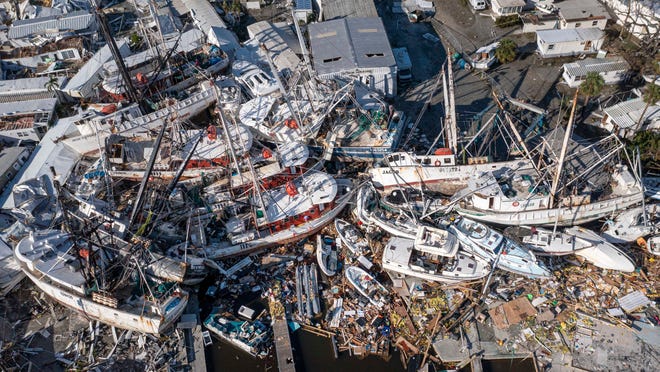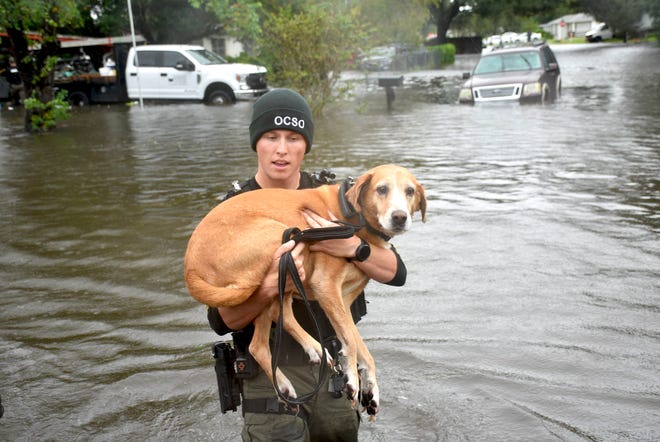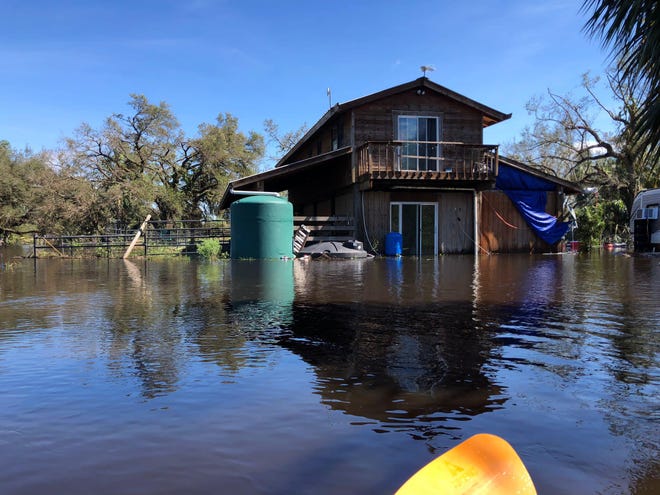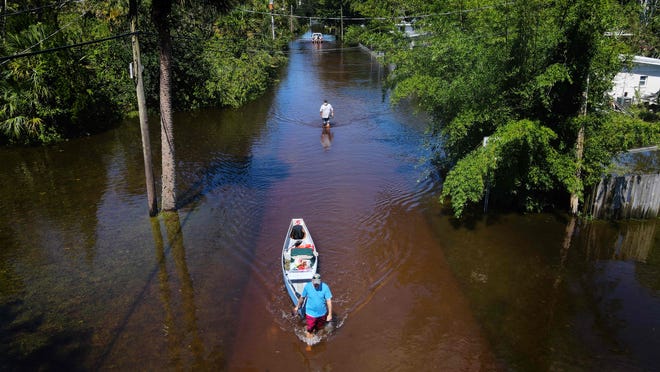Barbara Liz-Ortiz tried everything she could to bring her young daughter’s fever down, giving the child fluids and even a cold shower. The one thing she didn’t have was medicine, and she couldn’t leave her home to get any.
Like thousands of Floridians who weathered Hurricane Ian, Liz-Ortiz was trapped at home – not by devastating winds or storm surge but by catastrophic flooding.
“We can’t leave the house,” Liz-Ortiz said Thursday, when her family and many neighbors were stranded when water storage areas overflowed in their Buena Ventura Lakes subdivision in Kissimmee, Florida.
Ian drenched some areas with up to 17 inches of rain as it slogged across the state Wednesday and Thursday. Floodwaters spilled out of scenic lakes, ponds and rivers and into homes, forcing emergency evacuations and rescues that continued through Friday.
Researchers who study flooding, development and climate change were horrified by the emerging images but not surprised. For years, they’ve warned sprawling development in Florida and other coastal states isn’t sustainable, especially with the warming climate supercharging hurricanes.
“This is kind of what we had expected for days in advance, and it’s still heartbreaking to see so many people stranded,” said Kevin Reed, associate professor in atmospheric science at Stony Brook University in New York.
He and other experts said they expect Ian’s devastation to lead to a push for Florida to do more to protect residents from future flooding as the warming climate makes natural disasters and rainfall more extreme.
FLORIDIANS ESCAPE HURRICANE IAN TO CASINO ON EDGE OF THE EVERGLADES: They found refuge – and slot machines.
RISKY LIVING:Climate change makes living at the coast riskier. But more people keep coming.
“None of this is surprising,” said Linda Shi, an assistant professor in Cornell University’s city and regional planning department. “How much does it take for us to want to make a change? Our policies and our choices have led us to this point.”
Reed and colleagues recently published a study looking at all hurricanes during the 2020 season and concluded climate change was adding up to 10% more rain to today’s hurricanes. On Thursday, they used the same models to compare Ian’s rainfall, and concluded it was at least 10% higher than it would have been without the warming climate.
“This is one of the clearest indicators of how climate change is impacting storms,” Reed said. It may not seem like a lot, but two inches on top of an already large amount of rainfall makes an enormous impact. Over just one acre, that’s another 12.5 million gallons of water.
Across the region stream gauges soared, in some cases to record heights.
Ian’s heavy rain also exacerbated the effects of a few feet of storm surge on Florida’s east coast. In New Smyrna Beach in Volusia County, the combination of surging tides and more than 15 inches of rain sent one creek up nine feet in 12 hours. More than a half dozen weather stations in the county reported double-digit amounts of rainfall, according to the National Weather Service.
The county’s sheriff’s office responded to 600 calls for rescue, said spokesman Andrew Gant. One man died while waiting to be rescued from rapidly rising waters inside his home when he slipped and fell and the water rose above him before he could get up.
DOWNPOUR:How a summer of extreme weather reveals a stunning shift in the way rain falls in America.
A similar combination of rain and storm surge continued to prompt water rescues Friday in Flagler County, Florida.
In Manatee County, Tracy Berry, her husband and three children had been living in a camper on their property near Myakka City where they planned to build a home. On Thursday, they were safely huddled in an apartment in the top of their barn after the flooding Myakka River pushed its way into a stream behind their land and sent several feet of water across it overnight Wednesday and into the morning. The river had been near flood stage before the hurricane, then rose 8 feet in less than 24 hours.
“Right now, we’re still kind of in survival mode,” said Berry, a paramedic who also runs a non-profit animal rescue. “We actually are more prepared than some, since I am a first responder.”
A combination of high winds and water destroyed her husband’s shop and other small buildings. The family would make do as best they can with their menagerie of rescue animals, split between the apartment and a horse trailer, she said, but their horses were wading with no way to get them to dryer ground.
They “lost everything,” she said. It’s their family’s second such disaster. Their home and belongings were destroyed by the Black Forest wildfire in Colorado in 2013.
What can Florida learn from Hurricane Ian?
While Berry lives in an idyllic setting in rural Manatee County, much of the flooding in Central Florida took place in more developed communities like the one where Liz-Ortiz has lived for nine years. Researchers said that highlights the need for better planning.
Land use practices directly impact Florida’s ability to withstand water events, said John Dickson, president of the national Aon Edge Insurance Company.
“We can’t stop cyclone events or stop the rain from falling but we can build communities that are better able to withstand these events,” Dickson said. “We need to think about more resilient structure and we need to make a plan to handle the water and move it away from our people and our families and our property.”
“Mother Nature keeps telling us homes don’t belong where we built them, yet we continue to build homes where they don’t belong.”
The speed of the water’s rise along their street and around their backyard shocked Liz-Ortiz. A U.S. Geological Survey gauge in one creek near their area showed a 6-foot rise in less than 12 hours.
Liz-Ortiz said her husband’s car had been flooded and they were afraid to risk getting their other vehicle out of the garage and driving it through deep water to a pharmacy.
WHAT’S GOING ON WITH THE WEATHER? Subscribe to USA TODAY’s free weekly Climate Point newsletter
Before the storm, they felt safe in their home, confident in its ability to withstand the forecast winds, she said. They didn’t think the rain would be a problem. A neighbor had seen water in the street during a previous hurricane, she said, but never that high.
Liz-Ortiz said state and local officials should require building practices that reduce the risk of flooding and help homes be more resilient to water.
Developers are building houses “houses everywhere they can,” she said. “They need to be thinking more about the safety of the people, especially when there are so many hurricanes and tornadoes.”
Florida faces ‘painful choices’ on future development
Several experts said this week that Florida’s elevation makes it harder to drain away rain and easier for a storm surge to move farther inland, basic gravity that should have been taking into account more as the state developed.
Whether a storm water system is designed for rain that could occur once every 25 years or a rain that could occur every 100 years, the system would probably be overwhelmed with rain like Ian’s, said Chad Berginnis, executive director for the Association of State Floodplain Managers.
The state may have to accept the fact that if they’re going to have water over land, they’ll have to build at a higher elevation, he said.
Berginnis said iIt will be “interesting” to see if Ian’s massive flooding prompts the kind of rule changes for floodplain development that Hurricane Andrew’s 1992 destruction prompted in building code improvements.
There are “no easy fixes” in a state like Florida that attracts development to boost its budget coffers through property taxes, Shi said. That pits cities against each other, so officials fear if they require building to a higher standard, the developer would take a project to the next town.
“There’s a lot of places where people would like to make the right decisions,” she said. “It’s going to be really painful choices about foregoing development or requiring developments to meet higher standards. There’s a lot of reckoning for how long this can be sustained.”
Dinah Voyles Pulver covers climate and environment issues for USA TODAY. She can be reached at dpulver@gannett.com or at @dinahvp on Twitter.





